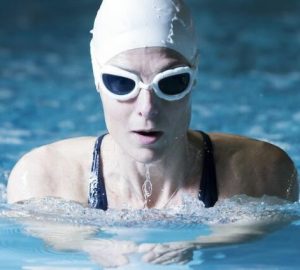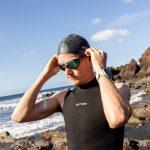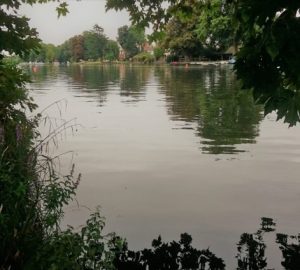Insight into a world-beating two-way English Channel relay
On 14 July 2013 a team of women calling themselves Andy’s Channel Ladies two-way World Record Breakers did exactly what they set out to do and broke a world record. At the same time we managed to raise funds for the British Heart Foundation, a charity that’s particularly important to us as two of the team (myself and Jane) suffer from heart conditions.
In brief, we accomplished a new all-female six-person two-way channel record of 18hrs 13mins, breaking the world record by nine minutes and the British record by 54 minutes. The team (in order of swimming) comprised Dee Llewellyn, Jane McCormick, Lucy Lloyd-Roach, Katie Birchall, Emily Gormley and Sarah Healey (see biographies below).
That summary above doesn’t do the swim justice. We swam on a 6.2m spring tide so faced a fair amount of flow and had to battle to cut across the tide in order to swim the shortest distance – not ideal for a record but it makes the achievement all the more satisfying.
High tide that morning was at 3:00am so the tide had been running for 40mins by the time I entered the water for the first leg at 3:40am and was pushing us up towards the port of Dover at quite a speed. It’s a really unique feeling swimming away from the boat into the beach in total darkness to start the swim – a feeling of apprehension and complete solitude at the same time.
This is how the swim unfolded, swimming in one hour shifts.
Dee: Air 14.8C, Sea 14.8C, no wind. Stroke rate: 72
The hooter sounds from the pilot boat and I do a running dive back into the water from the beach. It soon became light and the first jellyfish was identified by Sarah. After 50 minutes I got the 10 minute warning sign and dug deep, eventually I saw Jane McCormick getting ready to enter the water. Those final 10 minutes seem to take so long when you have pushed so hard. We had made good ground although the tide was running and pushing us up in a north east direction. If it hadn’t have been for the tidal flow it would have been the perfect day. The water was silky smooth and the temperature better than expected (in Dover harbour only four weeks prior it was a bitter 9 degrees Celsius) and although it was overcast the cloud cover kept the air temperature quite comfortable throughout the swim.
Jane: Foggy on East coast. Stroke rate: 78-74
Sarah and Katie fell asleep on the floor of the boat, a ferry passes and a gannet circles the boat. A seal is 50m from the boat with a huge skate in its mouth. Jane swam strongly for her hour, showing that having a baby doesn’t slow you down (she tells me she had just done a 10km swim before her waters broke).
Lucy: Air 15.3C, Sea 14.4C, Stroke rate: 70.
Lucy, with little sea swimming experience (just 10mins in Dover harbour the previous day), enters the water nervously. We have travelled 5.75 nautical miles. A tug passes towing a barge. We enter the SW shipping lane after 2h 15mins. It was here that we started to experience a few waves from the many tankers that were passing by. She swims through a shoal of whitebait.
Katie: Air 17.3C, Sea 13.8C, misty, no wind and calm sea. Stroke rate: 62.
Katie then leapt in and the sun started to rise leaving a nice bright glow on the water. We started to pass cargo ships and then came the seals. We saw a seal with a huge fish in its mouth shortly followed by many jellyfish and weed that Katie swam straight through. There are not many ships and we pass Gallivant (another Channel swim).
Emily: Air 22.9C, Sea 13.4C, Wind is 3 knots ESE. Stroke rate: 64
There is a big jellyfish in a swarm of smaller ones. We enter the separation zone after 4hr 20mins. We are catching two other channel swimmers out with Pathfinder and Rowena. Emily has cramp when she gets back on the boat, maybe a result of depletion of energy having been very sick with Kwells seasickness tablets she had taken the evening before the swim.
Sarah: Air 18.8C, Sea 12.6C, 1.5 knot wind ESE. Stroke rate: 64.
Sarah then completed the first rotation and we were now on the French side of the Channel, where the water was meant to be warmer – only it fell to 12.6C. We enter the NE shipping lane after 5hrs 2mins. Ferries are constantly passing.
Dee: Air 17.8C, Sea 13.4C, light wind. Stroke rate: 70
A racing pigeon hitched a ride, spots of rain are felt. The swimmer with Rowena aborted and Katie is being sick on the boat. Ships are coming close up the NE lane and it is difficult to see them because of the mist.
Jane: Air 13.5C, Sea 19.4C, Wind SW 1Knot. Stroke rate: 72-78.
The French coast is in the mist and there are lots of ships passing very close in front of us, in fact one tanker turns to avoid us and another was warned by Gris Nez traffic for being too close.
Lucy: Air 20.9C, Sea 14.6C, No Wind. Stroke rate: 70.
Dolphins are seen not far from the boat and we are now ¾ of a nautical mile from France.
Katie: Air 21.2C, Sea 14.2C, Stroke rate: 62.
There are lots of yachts and divers in the sea so we have to alter course. Sea Satin having finished their swim came over to cheer us on. Phil took the little dinghy into shore to accompany Katie to the side of Cap Gris Nez and at 13:02 and after 9hrs 21mins Katie climbs out on to the rocks. A strong and happy swim.
Emily: Air 26.2C, Sea 12.0C, Wind is 3.7 knots W. Stroke rate: 64
We pass a pod of dolphins.
Sarah: Air 31.5C, Sea 18C, No wind. Stroke rate: 64.
We enter the NE shipping lane again at 14:33 after 10hrs 52mins. Another boat changed course to avoid us. Katie is lying on deck in the shade and not feeling well. This is the first time she has been seasick but she feels ok in the water. A few other big boats pass by quite close.
Before the next rotation we were taking bets on the boat as to who would encounter the big patch of jellyfish that Katie had swum through on the way across to France. With this in mind we all lathered ourselves with seasafe, which we hoped would protect us from the jellyfish.
Dee: Air 31.9C, Sea 13.6C, Wind is 5 knots SSW. Stroke rate: 70
Another two tankers pass close by. At 16:30 Eric Hartley piloting Pathfinder with another swimmer called for help. He had an unconscious casualty onboard and needed a defibrillator.
We were later horrified to discover the other swimmer was Susan Taylor who tragically died during her attempted crossing.
Jane: Air 23.8C, Sea 14.1C, Wind W 3 knots. Stroke rate: 72-74.
After 13hrs 11mins we enter the separation zone on the return journey. Andy told Jane to speed up to get us on a better course, she obliged and after 13hrs and 37mins we entered the SW shipping lane and here they are, the jellyfish have arrived.
Lucy: Air 20.6C, Sea 14.6C, No Wind. Stroke rate: 74.
Poor Lucy had to jump into the middle of a pool of jellyfish. Yuk! She clears them and then there is another patch, she stops for a brief moment when she hits the weed and jellyfish soup. I shouted at her to swim through it as it was clear ahead. The SW lane is busy. Andy spots what looked like a dolphin but looking at the observer’s photographs this turned out to be a small shark. Eeekk! We are travelling at 2 knots. Lucy got cramp but managed to do her final 10mins.
Katie: Air 19.1C, Sea 13.8C, Wind 6.5 knots SW. Stroke rate: 62.
We exit the SW lane after 15hrs 20mins. Katie experiences problems with her goggles. Andy stops the engine whilst we pass Katie a new pair of goggles and a drink as he is having problems with weed in the boat’s engine.
Emily: Air 18C, Sea 13.8C, Wind is 9 knots SW. Stroke rate: 66.
At this point we were realising that the World Record was within our sights so we were all on deck shouting and cheering for Emily. Lucy shouted kick and Emily responded by showering us all.
Sarah: Air 17.1C, Sea 15.2C, Wind is 8.5 knots S. Stroke rate: 60.
Sarah takes to the water with light sticks attached to a costume and goggles as the sun begins to evaporate. The sun sets at 20:50. A dolphin surfaces a few times and we continue to shout and cheer. We now have a rough idea of our final destination, St Margaret’s Bay, so parents are informed, but I now realise I am going to have to re-enter the water and work hard for the World Record. The water is choppy as the tide has changed directions and we are getting backwash off the shore.
Dee: Air 16.5C, Stroke rate: 74.
I enter the water focussed and determined and sprint towards the lights at St Margaret’s Bay until Phil pulls the small dinghy ahead of me and I follow his spot light to the nearest point, ¼ mile south of St Margaret’s Bay. After leaving the side of the big boat where everybody was cheering me I could see nothing but the spot light on the dingy. I eventually start to feel thick weed so it can’t be far now. The dinghy has to stop and shine the spot light for me to follow to the rocks. I pull through the thick weed until I reach rocks. Scrambling quickly I get onto the rocks and slip off as they are covered in very slimy thick weed. After smacking my backside on the rocks and cutting my feet I finally clear the water.
My feet are stinging and I don’t know if we have got the record until I get back to the pilot boat. I feel a huge sense of relief and joy when I get out and the team are cheering. We have achieved our goal and broken the women’s two-way British record. I and my sister Liane were part of the team that set that time of 19hrs 07mins in 2004. The bonus was breaking the women’s two-way World Record which was set by a Dutch team in 2012 (18hrs 22mins). Our time was 18hrs 13mins. We negative split and returned in 8hrs 52mins (i.e. our return journey was faster).
This was a really great team experience we all pulled together and helped each other through the tough times. We shared ideas and experiences and we gave everything to achieve this so please keep donating and help us achieve out target of £10k for the British Heart Foundation.
(https://www.justgiving.com/Andyschannelladies)
Thanks for all your kind wishes and support – you kept us all going and we very much appreciate that.






